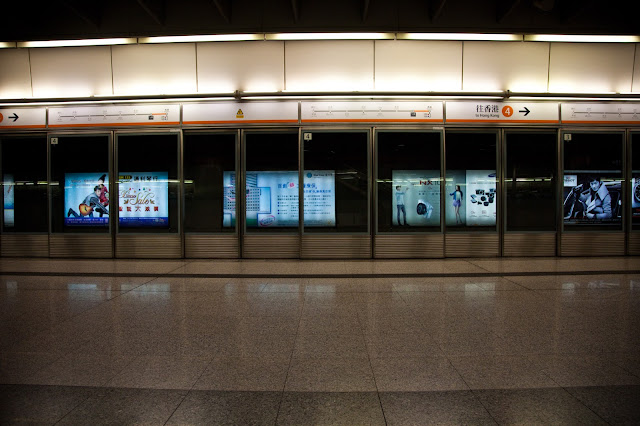Hong Kong has a unique blend of native vibrancy and colonial history which fascinates me and which I adore. Growing up in the 80s, I was told of Hong Kong as the place to get cheap designer clothing. And everything else, according to that vaguely racist yet catchy song from that era, "Made in Hong Kong." How obsolete were my ideas! When I finally visited it, it did not live up at all to its neon-legwarmers era reputation. Instead, I was immersed in a frantic, modern cosmopolitanism that rivals that of New York or Paris. Instead of rock-bottom discounts, I was faced with sky-high prices inside gleaming designer stores. I was mesmerized by it almost immediately, from the airport all the way to the city itself.
The view of the bay reminds me very much of San Francisco, down to the freeway that cuts through the city, the hills, and the water. This is from an area called North Point, which in turn reminds me of New York's Lower East Side meets Chinatown.
It's a dense city, its skyline filled with tall buildings that house its millions of inhabitants in very limited space.
Of course, for the Dineocrat, the most important point of culture is the food. Hong Kong's is glorious, especially to someone like me who loves Chinese food. One particular culinary strength: roast pork. This is just one of the many plates I had of the fatty marvel, but it had the characteristic of many Chinese roast pork that Filipino lechon doesn't: the skin's ability to stay crispy even when cold. Crispy skin is everything when it comes to this piece of meat, surely a sign of an advanced civilization.
Hong Kong restaurants also do vegetables right. Left, a tofu dish with conpoy (dried scallops), broccoli and pumpkin broth. In the non-veggie area, chicken wings stuffed with rice. Simple, tasty, addictive. Though I had dinner at the high-end French restaurant L'Atelier de Joël Robuchon, this kind of food is what's going to make me come back.
xoxo,
the dineocrat
The view of the bay reminds me very much of San Francisco, down to the freeway that cuts through the city, the hills, and the water. This is from an area called North Point, which in turn reminds me of New York's Lower East Side meets Chinatown.
It's a dense city, its skyline filled with tall buildings that house its millions of inhabitants in very limited space.
Of course, for the Dineocrat, the most important point of culture is the food. Hong Kong's is glorious, especially to someone like me who loves Chinese food. One particular culinary strength: roast pork. This is just one of the many plates I had of the fatty marvel, but it had the characteristic of many Chinese roast pork that Filipino lechon doesn't: the skin's ability to stay crispy even when cold. Crispy skin is everything when it comes to this piece of meat, surely a sign of an advanced civilization.
Hong Kong restaurants also do vegetables right. Left, a tofu dish with conpoy (dried scallops), broccoli and pumpkin broth. In the non-veggie area, chicken wings stuffed with rice. Simple, tasty, addictive. Though I had dinner at the high-end French restaurant L'Atelier de Joël Robuchon, this kind of food is what's going to make me come back.
Dim sum is also another marvelous experience here. I can probably do dim sum everyday simply because the variety can be nearly endless. In Hong Kong, it's hardly ever not good; even when it's just ok, it's above the quality of what I've had in other cities.
Below, from a popular dim sum restaurant called Serenade near Hong Kong's Cultural Center. Left, barbecue pork puff: near-perfect pastry, sweet-salty pork, sesame seeds; garoupa crystal dumplings, from the restaurant's "characterized dim sum" menu (probably for kids), where items are made to look like small animals (in this case, garoupa fish). Third photo: rice noodle roll with beef.
Dessert: sago dumplings in coconut milk, egg custard buns.
When in Hong Kong, take the train. Sorry, Paris and New York, as much as I love you, you can never have as clean and odor-free a train station as this one, at least not in my lifetime.
Here's a typical street scene in one of the major shopping areas, Tsim Sha Tsui. I happen to like big cities, so this isn't for the faint of heart. But for those who like the energy, there's nothing quite like it.
Another view of the calm-inducing bay amid the endless bustle.
Speaking of bustle, the boffo economy is eliciting lots of construction.
In one of the hotels where I stayed, lots of cool and whimsical design.
There's so much yet to discover and I'm planning on coming back this year.xoxo,
the dineocrat
















Comments
Post a Comment
Please keep comments clean and relevant to the article or discussion. The Dineocrat, in his infinite wisdom, will delete profanity-laced and irrelevant comments, as well as those with poor grammar.